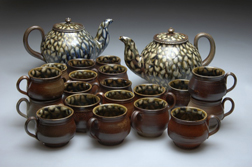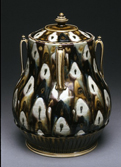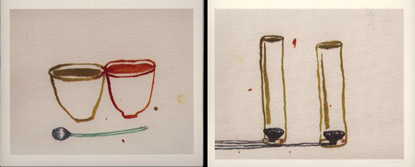Interpreting Ceramics | issue 12 | 2010
Articles & Reviews
To Eat, To Die, To Play
Linda Sikora, New York State College of Ceramics at Alfred University
(transcribed from the presentation given at the College Arts Association conference February 2009, Los Angeles. Some images are omitted from the original presentation.)
| Contents | Home |
|
by Mary Drach McInnes The Convergence of Parallel Tangents by Timothy John Berg by Lawrence A. Bush by Rory MacDonald by Michael Jones McKean Interdisciplinary Mind, Deft Hand by Annabeth Rosen by Linda Sikora by Linda Sormin by Michael Tooby Modern British Potters and their Studios by Douglas Phillips A Guide to Collecting Studio Pottery by Juliet Armstrong by Leah McLaughlin by Alan Wallwork |
| NB. A Word document is available to download at the end of each article. |
Prologue
We have before us a question of depth and a question regarding collaborative and interdisciplinary practice, a question of pedagogy, research and learning. While there may be a little squirming along the way towards semantic clarification; in essence, we all remain concerned about how to ask a real question. By real, I mean a question of relevance. What is a real question of depth and relevance and, how do we ask a real question of ceramic, a craft-design-art practice? What questions become culture; what questions lead to work that will enter and affect culture?
Following is a condensed introduction and approach to the above broad topic. My point of departure is two fold. One is from that of a medium specific practitioner working in the genre of functional ceramics/pottery (often an entry point for many who work with ceramics).
|
Fig 1. Linda Sikora, ‘Tea for Twenty’, porcellaneous stoneware, polychrome glaze, wood/oil/salt fire, teapot H.7in. |
Fig 2. Linda Sikora, jar, porcelain, polychrome glaze, wood/oil/salt fire, H.14 in. |
At Alfred University, my current employ, I teach undergraduate classes in this genre and advise at the undergrad and graduate level across genres. Secondly, I administer a program and work within a school whose strength is its studio-based program. It offers a non-major track of study at the undergraduate level and, three graduate programs based in fields of study, one being Ceramic Art, which support both specificity and multiplicity in theory and practice. The primary interdisciplinary activity in ceramics (not including cross-genre activity within the arts) is that of engineering and art, directed at materials research and, more recently, including 3D digital processes. Inter-institutionally we are working with the Central Academy of Fine Arts, City Design School in Beijing (a ceramic design program with factory internships – a linking of individuals on a ‘design education’ track and the phenomenal skilled labor force in China) and, beginning initiatives that involve upcoming collaborations with architecture and industrial machining/ design/fabrication programs at our neighboring SUNY institution, Alfred State.
In lieu of detailing the preceding, my introduction gestures towards the topic at hand by reflecting on the creative process and means by which genre specificity may be addressed - in its own right and, as a place from which multiplicity may issue forth. Following are two examples of addressing a traditional ceramic genre of specificity in this age – functional pottery. Sandwiched between these examples are a few comments on depth. The three sections, which are also three places from which to read/listen and teach are:
1. To Eat
2. To Die
3. To Play
1. To Eat:
To eat questions object-hood, desire, research and knowledge; it is about a cup … among many other things – it is simply comprised of a reflection on a quote from How Will I Know I’m Here a forty-five minute film by Toby MacLennan:
All around him, though unaware of their more secret mission, he saw that people were trying to eat the world just as they would sit down to a plate of roast beef and potatoes.
And he had to admit that on certain occasions in his own life he had loved an ocean wave or the sight of a particular toaster so intensely that he wanted to squash it into his own body. In mid empty air, to put his hands and arms around things and objects and push them into his chest and legs and into his face. ... To him ‘I want’ was part of the furniture. It stood in the world like a chair. And today he wanted to eat the room he was standing in . . .
Supposing an object, he thought, like a cup is simply a thing that moves its material in such directions that it wraps itself around space. Because you put your hand into the emptiness of the cup, you say ‘my hand is inside the cup,’ but the space inside the cup is just the still sky outside.
Perhaps looking moves in such directions that it too has a way of wrapping itself around space ... around a person, around a chair, around a house. And just the way that a hand gets into the emptiness of a cup, the objects of one’s life get into the body and seeing then is like an ocean who, momentarily wrapping itself around a stone, doesn’t need holes in it to fit in fish, the legs of birds and winter ...
He was not going to be afraid, he assured himself. It was just that no one before him had ever deliberately thought of biting into something without a mouth as a way to knowledge. 1
At one point the protagonist in the above soundtrack contemplates that he too is one of the objects in the room and will ultimately end up eating himself. In contemplating this, he wonders: ‘... if his mouth had to slowly fold over and around his own body wouldn’t the things his eyes had taken all those years to get inside of him soon be dumped out of him as he ate inward’. 2
This is a real question for someone who is eating the world and for anyone working their way through a world of objects, whether or not they have figured out how to eat them. It is a question of desire and knowledge – it is also a question about the meaning of objects, objects as performative, our assumptions about objects and space and, what it means to see:
‘I am I not any longer when I see’, said Gertrude Stein. 3
When one is truly engaged in seeing the world, the self (the ‘I’) disappears. The self is eaten. If one is truly seeing a cup, the cup disappears too.
2. To Die:
To die asks how to be alive in the creative process and what the gesture of that process is. In doing so it mulls over the panel content more pointedly.
There is a multiplicity of non-repeating patterns that emerge in the imagination when one thinks of the longstanding and newly forming links and connections between disciplines taught in institutions of learning.
Within the theory and analysis of a discipline we can construct extremes or micro contexts. Although we may use theory and analysis to tease things apart; in culture and in practice, everything is connected. Multiplicity is a ubiquitous state.
This question of specificity and multidisciplinary is far from a new question for educators. In relation to this question, it seems two elemental patterns of research in the arts have been differentiated and can be described as ‘lateral and ‘vertical’. Metaphorically, we see the lateral movement as horizontal/breadth/expansive/multidisciplinary/interdisciplinary, and we understand vertical as depth/excavation/intense focus/specificity.
In considering these elemental ‘x’ and ‘y’ axes alone, one can cover extended territory either by eating their way across the universe or burrowing down through the earth and beyond. Quantitatively, the accumulated knowledge/experience gained by traveling each axis may be commensurate. If we agree that the 21st century embodies living into complexity and difference – is breadth or depth more qualitative, valid, relevant, or urgent for contemporary culture? Does one occur at the expense of the other or are they inextricably connected too?
As a medium specific practitioner teaching/advising within and across visual art genres, this question of breadth/depth is a lived question.
Regarding depth, I have followed Helene Cixous to the ‘School of the Dead’. In Cixous’ book Three Steps on the Ladder of Writing, she takes us into the discipline of writing by first going to the ‘School of the Dead’ where we ‘ascend downwards’ - ascend because it takes effort to move downward – resistance is felt as if moving upwards against gravity:
When we climb up toward the bottom ... we’re searching for something: the unknown ...
Writing is learning to die. It’s learning not to be afraid, in other words to live at the extremity of life, which is what the dead, death, give us. 4
To enter the creative process (Cixous’ ‘to live’), is to take oneself to the edge of life, to the edge of losing oneself.
This edge is commensurate with MacLennan’s and Stein’s places of disappearance:
Eat a world of knowledge and ascend down to the unknown where you can truly see.
Teach in the ‘School of the Dead’ where unknowing and knowledge can be same thing.
Edges create energy:
Bill Viola wrote that human beings ‘require limits and boundaries [edges] to function. Our nervous system is one of difference registration. Boundaries create friction, and therefore create energy’.5
Question: If I am going to speak of collaboration, must I also speak of desertion?
Question: Should we attend to, more acutely, the proximity of disciplines, whether or not they cross, and would this not present the most ‘preposition-ally’ profound possibility?
3. To Play
To play presents a (‘found’) sound piece from an ongoing exchange with a colleague whose primary discipline is sonic art (Andrew Deutch) .The exchange with Andy began some time ago with a conversation about the’ atmosphere of pots’ and the ‘function of music.’
Winter Couplet uses two small teacups as a sound source – the teacups are ‘played’ and the sound registered in two small speakers in cardboard tubes.
(Copyright: New Plastic Music; Artist: Steve Roden – a sound piece inspired by the architecture of Shigeru Ban (b. 1957 Tokyo, Japan, known for use of elemental/recyclable materials – has used paper tubes as structure for refugee shelters and temporary public buildings.)
|
Fig 3. Steve Roden CD cover. |
Listen now: Linda Sikora
Notes
- Toby MacLennan, How Will I Know I am Here, Montreal, Burning Editions, 1994. back to text
- Ibid. back to text
- Gertrude Stein, quoted in Ulla E. Dydo and William Rice, Gertude Stein: The Language that Rises, 1923-1934, Chicago, Northwestern University Press, 2008, p.572. back to text
- Helene Cixous, Three Steps on The Ladder of Writing, New York, Columbia University Press, 1993. back to text
- Bill Viola and Robert Violette, Reasons for Knocking at an Empty House: Writings, 1973-1994. London, Thames and Hudson, p.224. back to text
Postscript: Follow Up Discussion (Q & A Session)
As a reflection upon the discussion following the panelist’s presentations, I would like to forward my observation that as we (educators) enter discussions about how to address educational models/methodology – I hope that we are looking towards creating structures that do not simply attempt to ‘mirror’ or train students to make work that ‘looks like’ art or will ‘fit in’ to the current consciousness of what art is or should be. Rather, we need to focus on creating structures that give the students the tools to move forward and re-make or re-invent what art is or might be; as they move into the world – to work beyond the typically ‘accepted’ or the ‘most rewarded’ or ‘most acknowledged’ approaches to visual output. The later involves much more risk and demands a more complex address than general or polarizing questions about skill or ‘inter-disciplinarity’ are likely to offer.
© The copyright of all the images in this article rests with the author unless otherwise stated
To Eat, To Die, To Play • Issue 12


